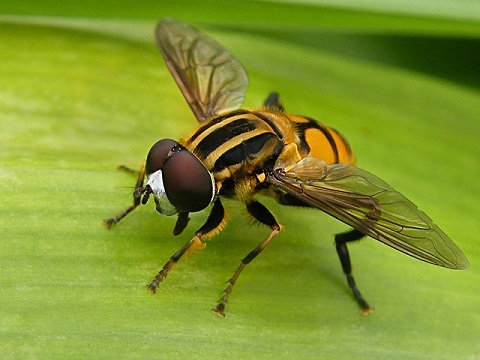How to tell a bee from a wasp from a fly

The Syrphid fly or hover fly has two wings, large eyes and short antenna. They are good pollinators and the larvae eat pest insects. They do not sting or bite. (Credit: Ian Jacobs via Flickr)
Can you tell the difference between bees, wasps and flies?
I met a few experts! Lora Morandin with Pollinator Partnership, Elizabeth Elle with Simon Fraser University and Cameron Cartiere with Border Free Bees helped me sort out the buzz from the sting from the pesky.
Why know the difference?
Some people panic and kill beneficial insects. And that's a problem, because:
More than half of native bee species in North America are declining and almost one-quarter are at risk of extinction. The western bumblebee (look for the cute white bum), for example, is at risk of extinction.
We rely on managed honeybees and the 20,000-plus species of wild bees. They help plants reproduce, create berries and seeds for wildlife, and pollinate about one in three of the food items we eat!
Flies and wasps are part of nature's cleaning crew. Some are pollinators and eat pests. (Some flies and wasps become pests when their numbers increase in urban areas.)
Native bees rarely sting people and almost never become "pesky."
Wasps eat aphids!
Ten clues to identifying bees, wasps and flies
Is the insect...
Cute? It's probably a bee! Male bumblebees even have moustaches. Wasps and flies have antennae lower on the face.
Interested in your food? It's a fly or a wasp. Bees are vegetarians. They eat pollen and nectar from flowers. They're not interested in what you're barbecuing.
Hairless, shiny, with four, long, narrow wings, a bright-coloured abdomen and interested in your food? Likely a wasp (e.g., a yellow jacket or paper wasp). Wasps are carnivores -- they eat meat, aphids and caterpillars.
Inside a flower? Probably a bee! A wasp is more likely to be under leaves or flowers hunting for aphids.
Stinging you? If it has a long, streamlined body with a thin "waist" it's likely a wasp. Bees are chubby. Native bees don't sting unless they become trapped in clothing or you disturb a nest. Even then, most won't sting.
Coming out of a paper or mud nest hanging from a tree or your house? It's a wasp.
Carrying pollen on its back legs or under its belly? It's a bee. Wasps and flies don't carry pollen.
Has only two wings (one on each side)? Probably a fly. Wasps and bees have four wings, two on each side.
Has large, bulging eyes, short antennae and two wings? It's a fly. (Pay attention: Some flies are bumblebee mimics!)
Has a long "stinger"? Probably a wasp. But it can't sting! What looks like a stinger is an ovipositor, used to deposit eggs. Bee and wasp stingers evolved from ovipositors.
We need these critters. And we can all do something about what's causing their decline: habitat destruction, pesticide use, urbanization and climate change.
What's your secret to coexisting with bees, wasps and flies?
Sincerely,
Lindsay Coulter, a fellow Queen of Green
Hey! Want more DSF? Join David Suzuki on Facebook

David Suzuki's Blog
- David Suzuki's profile
- 247 followers



